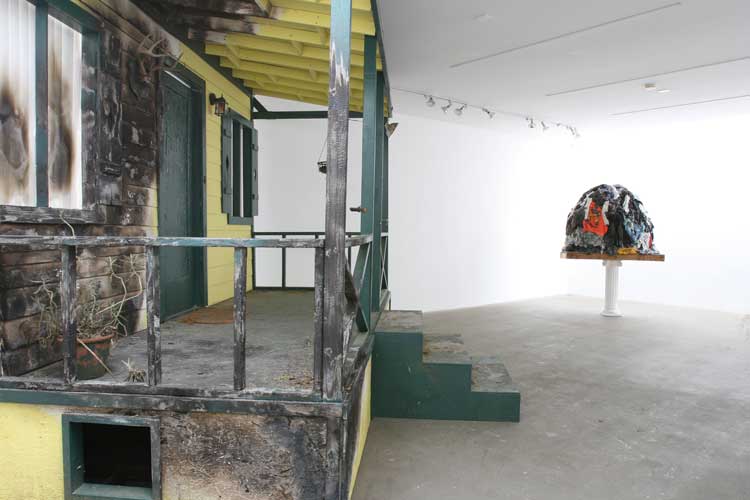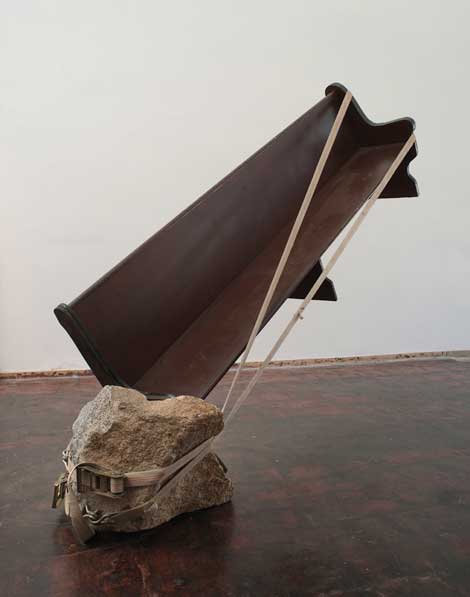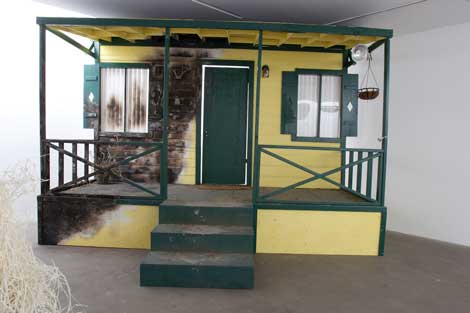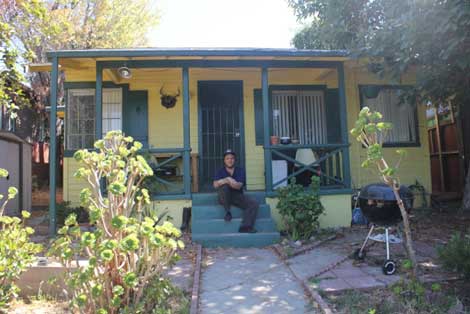Up-and-coming Los Angeles-based artist Christian Tedeschi describes his former boss, Nancy Rubins as “a tornado—so much energy.” The 40-year-old assistant professor and head of sculpture at Cal State Northridge recalls his experience as a studio assistant with a combination of reverence, awe and pragmatism. His admiration for Rubins—both as an artist, and as a person—is clear. “She is no bullshit—sweetest lady in the world—but she is hardcore in the best possible way,” he says. He was in New York recently to see Rubins’ solo show “Our Friend Fluid Metal” at Gagosian Gallery, and at the reception, Rubins came up behind him and gave him a big hug.
Rubins’ no-bullshit ethos made her studio a solid, no-drama environment to work in. Tedeschi is quick to point out that both Rubins and her husband Chris Burden maintain professional studio practices that run like small corporations. “They are very aware that they are employing people. They know they are helping out artists, that they’re giving them experience. But they will never talk about that. They’re very modest.” They’re also self-sufficient.
Tedeschi never experienced any personal-life bleed over or professional confusion while working for Rubins. She never asked him to get coffee or pick up the dry cleaning. She never solicited his opinion about her work, and there was never any question about ownership. He had a clear role in the studio, and Rubins did the heavy lifting, creatively. He spent a lot of time making steel cable and cutting objects for collage. Yet it is clear that he feels a bond with Rubins.
“Seeing her show,” he says, “I was so happy for her and sort of proud of her. She uses found objects in a way that no one else does, and she finds tension in things that are impossible.” He also found her commitment to her work impelling. He recalls while working on collages for Rubins, going to her garage where she works on her drawings to ask a question. He found her sitting on the floor with a drawing, completely immersed, surrounded by pencil nubs. “I think she’s really in the moment.”
Tedeschi, whose solo at Western Project, “5244 Baltimore,” wrapped in June, speaks highly of the other artists he met while working for Rubins. He considers the formation of peer relationships one of the most important benefits of working as an assistant. Originally from the East Coast, he earned an MFA at Cranbrook and began teaching in Detroit immediately after graduate school.
He experienced a bit of a rough patch after coming to Los Angeles. Following a stint as an adjunct at CSU Long Beach. “I was kind of living in my car,” Tedeschi said. He saw Evan Holloway, whom he had brought to Long Beach as a visiting artist, at an opening. Upon learning Tedeschi was no longer teaching, Holloway offered him a job renovating his house. As the work ran out, Holloway said he might be able to get Tedeschi work in Chris Burden’s studio. Tedeschi was keenly interested but privately doubted it would happen. Yet, he soon found himself working on Metropolis II (Burden’s wildly popular 2010 installation which resides at LACMA).
It was a project that required a lot of precision work with extremely tight tolerances. Tedeschi remembers thinking, “I don’t know any sculptor that is [in] like a machinist-type job, so it was really difficult. And here is my hero, Chris Burden, and I’m like, fuck, I can’t do this job. I’m not this good!” It was very intense, and when they started fabricating the road track, Tedeschi actually lost sleep.
After a while he started receiving offers to teach and needed to reduce his hours. Rubins needed a part-time assistant, so he switched studios. He felt his way of working fit perfectly with her.
Rubins talked a lot about Arte Povera, the Italian art movement that emerged in the 1960s. Dubbed Arte Povera, literally, poor art, by Italian critic Germano Celant, the movement sought to blur the distinction between art and life, and artists made use of found objects and common materials. Arte Povera was a significant point of connection for Tedeschi. In graduate school, he became interested in Piero Manzoni, whose work prefigured Arte Povera. Tedeschi began to think about the intimacy of materials in response to Manzoni’s piece, Artist’s Breath (1960)—a balloon, inflated by the artist’s breath, which gradually deflated and came to rest on its pedestal. He began making sculpture out of gum, which “had all this great material language embedded in it: your saliva, everything goes into this intimate space and comes out. It can trap your breath. And that opened up a world. I could see the poetry embedded in the material.”
When he moved to Detroit in the early 2000s, Tedeschi responded to the proliferation of trash and castoff consumer goods by making art out of the abundant refuse. The polyurethane and bristle sculptures that are some of his best known work arose from necessity. He began making them at a time when he was struggling financially and material—any material—came at a premium. He started cutting his own hair and gluing it together and eventually moved to brush bristles.
His show at Western Project deepened his exploration of art and life boundaries. It came to be about not just his home—the show’s title is also the street address of his Highland Park residence—but his neighborhood and the things he sees as he wanders through it. Niche (2014) is inspired by the shrines to the Virgin Mary that decorate his community. It is disconcertingly faceless—a golden wig surrounded by a parabola of sheeted metal on one side and hundreds of discarded clothing encased in polyurethane on the other, sitting atop a neoclassical column. It also bears an uncanny resemblance to Michelangelo Pistoletto’s Venus of the Rags (1967). The gallery installation included Saddle (2014), one of his polyurethane and bristle sculptures. It rested a few feet from the front step of 5244 Baltimore (2014), an exacting verisimilitude of his home’s façade, as if he had just stepped away while working on the piece.
But Rubins taught him about tension. In 2010, he made The Spider and the Fly (2010), a church pew cantilevered from a 650-pound piece of granite with ratcheting nylon straps. Revolution 1 (2014), a broom suspended from a ceiling fan (exhibited in “5244”), also feels related to the tension in Rubins’ sculptures, in the way the broom jerks unpredictably as it follows the fan’s rotation. (Tedeschi once retrieved a broom that Rubins tossed in the trash, hoping to use it in a piece.)
Tedeschi is reflective about making art. “Nancy told me one time,” he said, “‘Your art practice is a little flame, and you have to protect it. No matter what, you have to keep it lit, even if it’s just a flicker.’” He adds, “It’s really frustrating sometimes; it’s really painful sometimes. At certain times you feel like you’re on top of the world and then you feel like a total loser. It’s this constant introspection and self-doubt. Maybe someday I’ll get to where Nancy is.”





